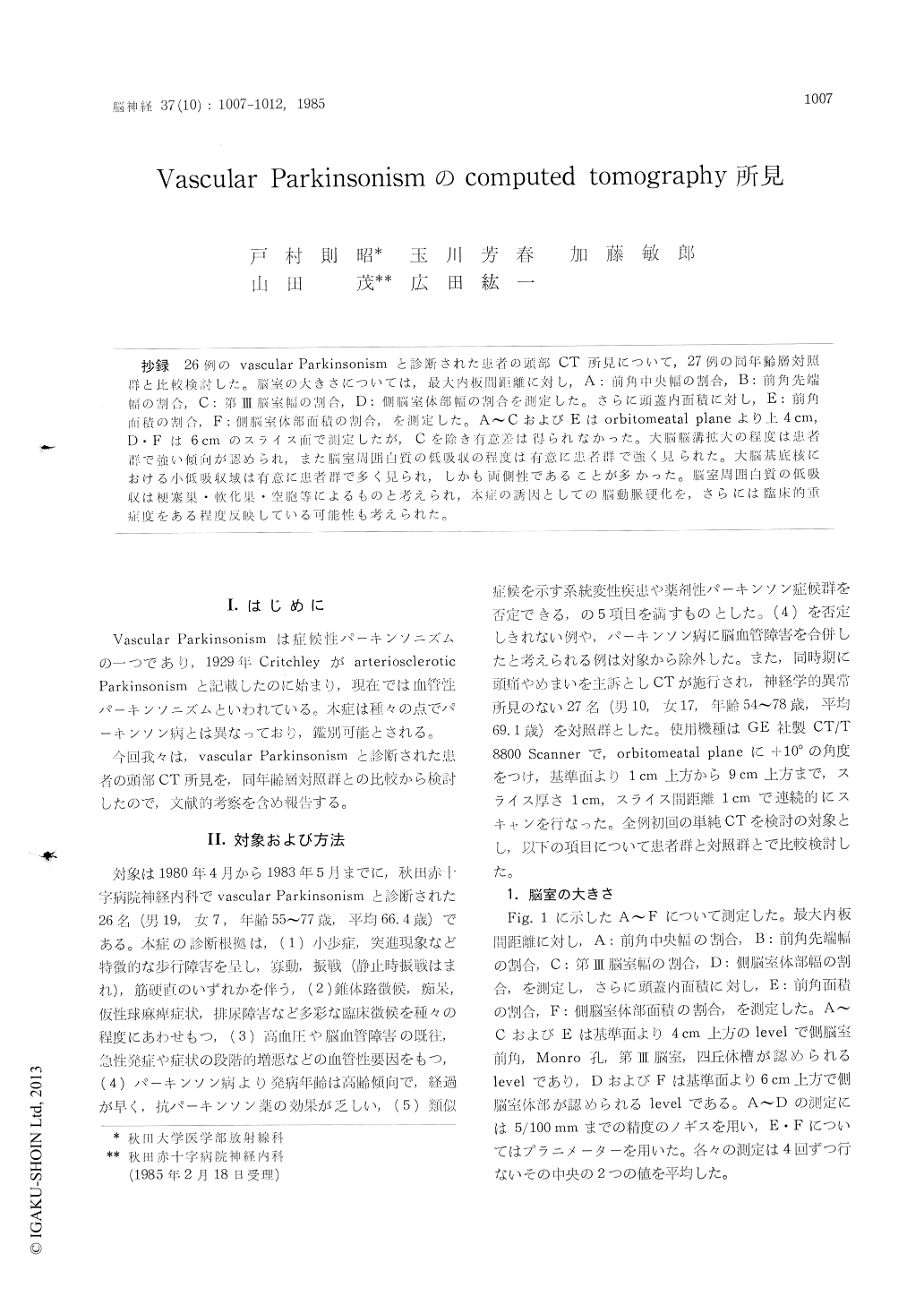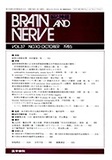Japanese
English
- 有料閲覧
- Abstract 文献概要
- 1ページ目 Look Inside
抄録 26例のvascular Parkinsonismと診断された患者の頭部CT所見について,27例の同年齢層対照群と比較検討した。脳室の大きさについては,最大内板間距離に対し,A:前角中央幅の割合,B:前角先端幅の割合,C:第II脳室幅の割合,D:側脳室体部幅の割合を測定した。さらに頭蓋内面積に対し,E:前角面積の割合,F:側脳室体部面積の割合,を測定した。A〜CおよびEはorbitomeatal planeより上4cm,D・Fは6cmのスライス血で測定したが,Cを除き有意差は得られなかった。大脳脳溝拡大の程度は患者群で強い傾向が認められ,また脳室周囲白質の低吸収の程度は有意に患者群で強く見られた。大脳基底核における小低吸収域は有意に患者群で多く見られ,しかも両側性であることが多かった。脳室周囲白質の低吸収は梗塞巣・軟化巣・空胞等によるものと考えられ,本症の誘因としての脳動脈硬化を,さらには臨床的重症度をある程度反映している可能性も考えられた。
CT findings in the patients with vascular Par-kinsonism were discussed. We investigated 26 patients who were clinically diagnosed as vascular Parkinsonism aged from 55 to 77 years old (mean 66.4), and compared with 27 controls aged from 54 to 78 years old (mean 69.1).
In order to evaluate the ventricular size, we measured the following A-F. A : The ratio of the ventricle-caudate nucleus distance to the maximum transverse inner diameter of skull on 4. 0 cm above orbitomeatal plane. B: The ratio of the largest width of the anterior horn of the lateral ventricle to the maximum transverse inner diameter on the same level as A. C: The ratio of the maximum width of the third ventricle to the maximum transverse inner diameter of skull on the same level as A. D: The ratio of the minimal width of both cellae mediae to the maximum transverse inner diameter on 6.0 cm above orbitomeatal plane. E : The ratio of the area of both the anterior horn to the intracranial area on the same level as A. F : The ratio of the area of both the body of the lateral ventricle to the intracranial area on the same level as D. C was only statistically significant compared with controls.
The enlargement of cerebral cortical sulci in patients was more prominent than that in controls. The degree of periventricular lucency in patients was more severe than that in controls.
The number of small low density area in basal ganglia in patients was more than that in controls.
The pathogenesis of periventricular lucency in the patients with vascular Parkinsonism differs from that in the patients with obstructive hydro-cephalus. The periventricular area corresponds to border zone in the arterial angioarchitecture in the brain, therefore, the periventricular area undergoes easily ischemic changes than the other area. It is thought that the periventricular lucency in vascular Parkinsonism is due to the infarction, softening, vacuoles etc, and reflects the cerebrovascular arteriosclerosis. Furthermore, in view of the cor-relation between CT findings and clinical symp-toms, the periventricular lucency reflects well the clinical severity.
In the patients with vascular Parkinsonism, the detailed investigation of CT findings is useful in diagnosis and judging the clinical severity.

Copyright © 1985, Igaku-Shoin Ltd. All rights reserved.


